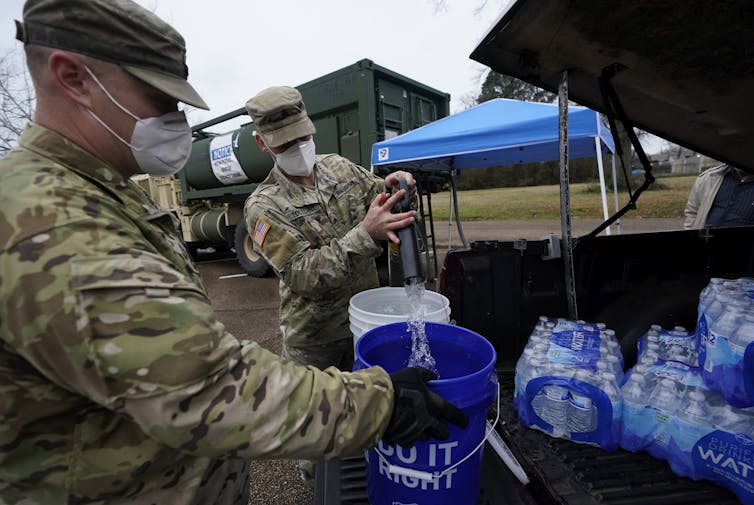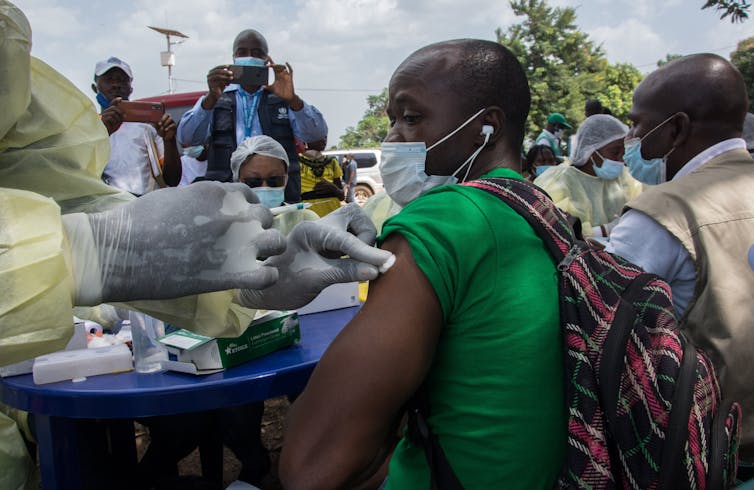There WILL be a next one - five things we can do now
Tiffany A. Radcliff, Texas A&M University and Angela Clendenin, Texas A&M University
 |
| Stacked disasters – like a winter storm that damages a water system during a pandemic – can provide lessons for the next time around. AP Photo/Rogelio V. Solis |
We are public health researchers engaged in both leading public health disaster response and evaluating emergency management.
Here are five strategies that will give the world a head start – and maybe even help prevent the next outbreak or epidemic from blowing up into a pandemic.
 |
| The public health response in Guinea was swift when new cases of Ebola virus disease were identified in February 2021. Carol Valade/AFP via Getty Images |
1. Shore up the systems already in place
The identification in February 2021 of a new outbreak of Ebola in Guinea showed how critical surveillance and reporting are for rapidly responding to and containing infectious disease.
The process generally works like this: Once an astute clinician diagnoses a disease that is on the watch list of the World Health Organization and the Centers for Disease Control and Prevention, she reports the case to local health authorities to investigate. The information gets passed up the chain to the state, federal and international levels.
Clinicians, public health practitioners and labs all around the world send disease reports to groups like the WHO’s Global Outbreak Alert and Response Network. It aggregates all that data and helps identify outbreaks of new infectious diseases and their pandemic potential.
If a pathogen does make it past local monitors and starts to spread, governments have emergency management systems in place to respond. These incident command structures provide a framework to respond to crises that range from infectious disease to natural disaster to terrorist attack.
In the U.S., various federal agencies have different responsibilities. They monitor emerging infectious diseases, establish a strategic national stockpile of resources and support the states in their preparedness and response.
Responsibility for the emergency response lies with each state – that’s in the U.S. Constitution – so they have flexibility in how they implement everything on a local level.
One practical way to be prepared for a future pandemic is to ensure that all these systems and structures remain stable. That means maintaining funding, training and personnel for a rapid global response even when no pandemic threats are visible on the horizon.
2. Prepare the public to do its part
Effective pandemic response requires a clear, consistent voice and an actionable message that reflects best practices based on sound science. Messaging and data that clearly explain how each individual has an important role in curbing the pandemic – and that it might evolve as the pandemic unfolds over time – are critical.
The message to stay home and “flatten the curve” to avoid overwhelming health care resources with COVID-19 cases was an essential early public health message that resonated with many Americans who were not designated as essential workers.
However, once initial shutdown orders were lifted and new treatments emerged, there was general confusion about the safety of public gatherings, particularly since guidance varied by state or locality.
Guidance is also most effective if it’s tailored to different audiences. In the South, distrust of testing and vaccination efforts by government and health care providers is directly linked to language barriers and immigration concerns.
One strategy to reach diverse and often underserved populations is to rely on leaders in the local faith community to help deliver public health messages.
Preparedness requires an “all of community approach” that engages everyone in the planning stages, especially those from underserved or vulnerable populations. Building relationships now can improve access to information and resources when the next disaster strikes, helping ensure equity and agility in response.
Science and risk communication scholars have started talking about the best ways people can manage the flood of information during a pandemic. Lessons from what’s been called the infodemic of COVID-19 news – some trustworthy but some certainly not – can inform new strategies for sharing reliable info and fostering trust in science.
 |
| Participants at a tabletop exercise in Texas that envisioned an Ebola virus disease outbreak. The USA Center for Rural Health Preparedness, CC BY-ND |
Emergency managers and health care leaders have long recognized that a coordinated response by diverse teams is critical for public health emergencies.
Tabletop exercises that simulate real emergencies help officials prepare for crises of all types. Like a fire drill, they bring together community stakeholders to walk through a hypothetical disaster scenario and hash out roles and responsibilities.
These practice sessions include people who work in public health, emergency management and health care, as well as federal, tribal, state and local front-line responders.
Practice scenarios must also include the reality of “stacked disasters,” like a hurricane or winter storm that puts even more stress on the disaster response system.
These exercises enable a community to test parts of the overall emergency management plan and determine gaps or areas to strengthen. Ongoing testing and training to the plan ensures everyone is as ready as they can be.
Beyond this training, health care professionals could be cross-trained to back up specialized clinical staff, who may need support over the course of a long pandemic.
The COVID-19 pandemic delivered lessons about infrastructure and supply chains. Strategic investments can shore up existing strategic national stockpiles of supplies and vaccinations for the future. If necessary, the president can use the Defense Production Act to order private companies to prioritize federal orders.
4. Polish the playbook
After every major disaster response, all of the different groups involved – law enforcement, EMS, fire, emergency management, public health, search and rescue and so on – conduct what are called “after action reviews.” They can improve plans for the next time around.
For instance, after the 2009 influenza pandemic, the Department of Health and Human Services found that while CDC communication efforts were widely successful, some non-English-speaking populations missed important messages.
The after action review noted that distrust in the government increased when vaccine supplies did not meet public expectations. In turn, officials could plan exercises to test and tweak approaches for next time.
A thorough review of the response to the current COVID-19 pandemic at all levels will identify gaps, challenges and successes. Those “After Action” findings need to be integrated into future planning to improve preparedness and response for the next pandemic.
 |
| A previous pandemic hastened the end of switchboard operators. Which technologies will get a boost after this one? Stevens/Topical Press Agency/Hulton Archive via Getty Images |
5. Build on the new normal
Back when the 1918 H1N1 influenza pandemic unfolded, few Americans had a telephone. Quarantine rules led more households to use phones and hastened research that reduced reliance on human telephone operators.
Similarly, no doubt COVID-19 triggered some rapid changes that will last and help the U.S. be ready for future events.
It’s been easier to adapt to the necessary lifestyle changes due to this pandemic thanks to the ways technology has changed the workplace, the classroom and the delivery of health care.
Business analysts predict the quick move to video teleconferencing and remote work for offices in 2020 will be lasting legacies of COVID-19. A multidisciplinary team here at Texas A&M is tracking how robotics and automated systems are being used in pandemic response in clinical care, public health and public safety settings.
Some of the sudden, dramatic changes to norms and behaviors, like the use of face masks in public, may be among the easiest strategies to keep in place to fend off a future pandemic from a respiratory virus.
Just as telephone systems continued to improve over the last 100 years, ongoing innovation that builds on rapid adoption of technologies around COVID-19 will help people adjust to sudden lifestyle changes when the next pandemic strikes.
Tiffany A. Radcliff, Associate Dean for Research and Professor of Health Policy and Management, Texas A&M University and Angela Clendenin, Instructional Assistant Professor of Epidemiology and Biostatistics, Texas A&M University
This article is republished from The Conversation under a Creative Commons license. Read the original article.